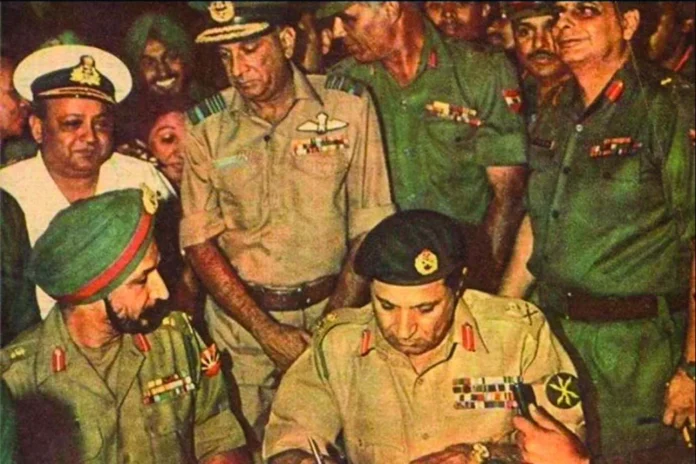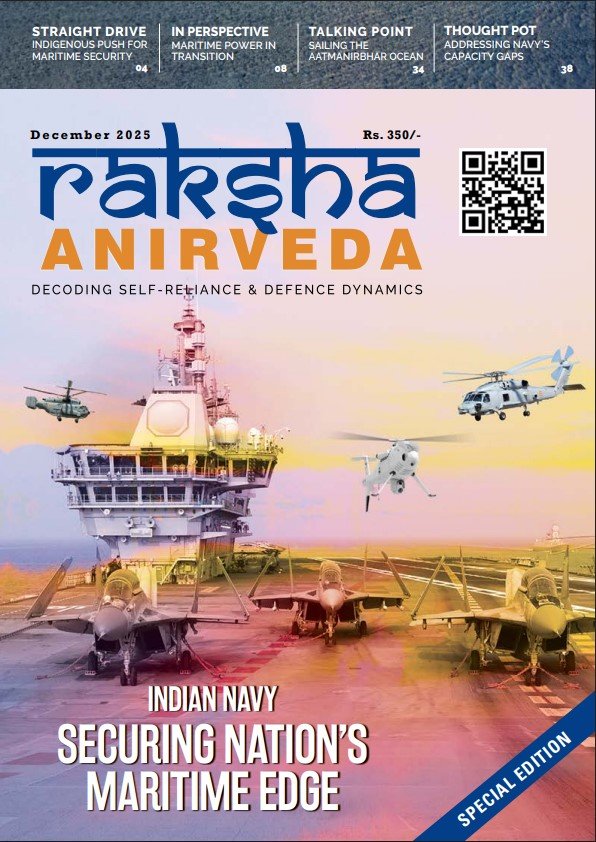India celebrates VIJAY DIWAS on December 16 to commemorate 51 years of Victory in Bangladesh. Last month, Defence Minister Rajnath Singh was on a day’s visit to the India-China border in Eastern Ladakh. This was his second visit during a span of a few weeks. He made a specific mention of the part of the State of Jammu and Kashmir under Pakistan’s illegal occupation and said that India will take back PoK in accordance with a resolution passed unanimously in Parliament in 1994. Accusing Pakistan of torturing and harassing the people of PoK, he defined the political will of the New Bharat. A few days ago, in a TV panel discussion, the anchor asked me, “Sir! When are we taking back PoK?” I smiled and said, “It is a feel-good factor.” Is India preparing for Bangladesh War Season 2? Let’s have a reality check.
Political Will
India had four golden opportunities that Pakistan presented in the form of four wars they lost, but we didn’t do it that time. India has always believed in peaceful co-existence and many times made friendly moves for good neighbourly relations with Pakistan but every time, we have been betrayed with a hostile posture and increased terrorist activities from across the border.
India is progressing well as the fastest-growing economy in the world and today we are a power to reckon with. Any misadventure will derail the economic progress and take the country back by more than a decade or so. War is a costly hobby and the price of war in terms of economy and human lives will have to be clearly weighed by the decision-makers before we undertake such bold action.
India has amply demonstrated our political will to take revenge for anti-India activities and Pak-sponsored terrorism by surgical strikes in 2016 and then airstrikes at Balakot in 2019. History is also testimony to the fact that we liberated Bangladesh and broke Pakistan into two parts, in just 14 days. Pakistan army has not yet got over the shame of 93000 soldiers surrendering to Indian armed forces in 1971. They still carry that stigma and it found a place in the farewell speech of the previous Pak Army Chief, Gen Qamar Javed Bajwa. The defence minister’s statement on PoK manifests the changed political will of New Bharat.
Military Capability
India’s Armed Forces are among the world’s largest defence forces because India has the largest unsettled borders of approx 4800 km with two aggressive neighbours, who are also nuclear powers. India is truly justified to have high defence spending for the operational readiness of such a large force. Militarily, India is better equipped today for a future war, as compared to 1971. However, taking on an offensive of the magnitude of taking PoK back will need detailed thought. The following aspects merit consideration:
-
India and Pakistan have formidable defence systems and layers of multiple obstacles along the ‘Line of Control (LC)’ between PoK and the Indian side of J&K. The pace of operations will therefore be slow in such obstacle-ridden terrain.
-
Any initiative of India in the context could result in a regional war in which China and Pakistan would be openly corroborating while India would have to fight her battle single-handedly. China has heavily invested in PoK and won’t let it slip out of its control. It will also supply all the military hardware to Pakistan, thereby keeping India embroiled in the conflict without any tangible gains.
-
Even if China doesn’t open up the Eastern Borders of India actively taking part with Pakistan, China will certainly deploy its forces on LAC with India and tie down a large number of Indian forces in the Eastern theatre of war.
-
Limited resources of the Indian Air Force and Indian Navy will be split into two fronts and may not be adequate for achieving air domination and naval blockade in the intended sector.
-
India has three strike corps, as offensive forces. One is poised for China Sector, the second for deserts of the Western Sector and only one strike corps is left for an offensive in J&k. The terrain friction and multiple tiers of defences will impede the movement of this offensive. Therefore, taking the entire PoK with one strike corps may not be feasible and committing more troops to PoK will unbalance the entire western front.
-
Let’s not underestimate our adversary. Pakistan’s army is also a trained and well-equipped force, which will resist every military movement to take over PoK. Anti-India feelings and Kashmir are the two types of glue that bind the nation together. Therefore, expect the best from Pak Army while defending PoK.
-
Indian wargames and military exercises only plan for 14 days of intense war, which could be prolonged to a month and with the aim to achieve the military objectives within this timeframe, before international pressures and economic compulsions force a ceasefire. Taking the entire PoK in such a short period may be an outstretched military objective. Even Russia has not been able to do so against the militarily lightweight Ukraine army in nine months.
-
In 1971, India could liberate Bangladesh in 14 days because of the full support of the Mukti Bahini Sena and the local population. However, the same may not be the case in PoK. The local population of PoK may be unhappy with the Pakistani government but won’t like to merge with India either.
Justification of War
India had gone to the UN in 1948 with the Kashmir issue and thereafter in various forums, India has always reiterated that the sanctity of LC should be maintained. Pakistan leaves no opportunity to keep the Kashmir issue alive in the international forum. LC is now accepted as ipso facto border between India and Pakistan. Even during the Kargil war, defence forces including Indian Air Force were not permitted by the Indian government to violate the sanctity of LC, in order to project India as a mature democracy, to the international community. Therefore, now changing stance and going into PoK, will be difficult to justify.
Taking PoK by force from Pakistan will have to be legitimately justified to the world. Though powerful nations can do anything and justify it like China took over Tibet and Russia annexed Crimea. Russia’s invasion of Ukraine is also based on religious and cultural ties and ethnic similarities. General public uprisings are also engineered to create a valid reason. However, the world does not agree with such arguments and annexation of territory by force is not approved in the 21st Century. India has also made it clear in the Ukraine conflict that it does not favour war as a means to resolve international disputes. PM Modi is on record saying, “This is not an Era of war.”
International Opinion
India’s stand of principled neutrality during Russia’s aggression in Ukraine has also not been taken kindly by the West and the USA. India has her reasons and we are working in our national interests. But the so-called free world has framed a negative impression of India.
China being a member of the UNSC will take the lead to declare India as an aggressor. A large number of economic and diplomatic sanctions will be slapped on India. At present, India is a fragile economy with 65 per cent imported war equipment and large import of oil. After the Ukraine war and prolonged sanctions, Russia will be too weak to support India and veto such resolutions, against the wishes of China. Therefore, India will be throttled to stop the war, by the West and China. It will have to pay a heavy price for taking PoK, with only a political advantage. It will add poverty, underdeveloped area and more underprivileged population to India’s problems.
Chaos in Pakistan
Pakistan is in utter chaos today due to the economic crisis and political turmoil. Nature has also not been kind and ravaging floods have also added to its woos. Hardliners and extremist organisations are calling the shots over the weakened government and non-assertive Pakistani Army.
Economic Crisis. Pakistan’s current economic indices are quite poor. According to the UNDP, Pakistan is facing a debt in excess of USD 250 billion. Since the start of 2022, the Pakistani rupee has lost over 30 per cent of its value. GDP growth is only 2 per cent in the current fiscal year. The current rate of inflation shooting to 23 per cent. The cost-of-living crisis is sinking millions of people into poverty and even starvation. The recent floods are expected to have a substantial negative impact on Pakistan’s economy. Pakistan was on the Grey list of the Financial Action Task Force (FATF), for four years and did not get any monetary assistance from IMF and the World Bank. With the present state of the economy, Pakistan is on a ventilator and heading towards collapse similar to Sri Lanka.
Political Turmoil. Pakistan society today is almost on the brink of a civil war. It has already sunk into chaos and disorder, and the writ of the civilian, as well as the military administration, is hardly visible. Never has Pakistan been in such a disarrayed situation as now, owing to her internal politics. Islamabad and Rawalpindi are in churn. The Shehbaz Sharif government, besieged by a crumbling economy and skyrocketing inflation, is visibly under pressure. Religious hardliners and extremist forces are dominating the political arena. Further rise in tempers will lead to more violence and civil unrest.
Pariah PoK
The region has also been linguistically and culturally marginalised by Pakistan rulers, for nearly 75 years. The people of PoK are being deprived of all basic rights by Pakistan and it remains an underdeveloped territory with a lack of infrastructure, due to Islamabad’s apathy. PoK has suffered many budgetary cuts by successive governments. China is making inroads into this territory to fulfil its ambitions. PoK is presently at the crossroads of Conflicting Interests of India, China and Pakistan.
The stark contrast in the development of the two Kashmirs has created unrest in Pakistan-occupied Kashmir (PoK) as India is implementing several new projects in Jammu and Kashmir to meet the demands of its citizens. Sentiments against Pakistan are fierce and alarming. Political unrest is brewing in PoK primarily because of the denial of basic rights. The establishment has brutally crushed political unrest in PoK in the past. PoK is likely to become the geo-strategic chessboard among India, China and Pakistan.
Conclusion
Crystal gazing into the future indicates that there is considerable anti-China feeling spreading in Pakistan. In due course, if they fall apart like the USA and Pakistan, the geo-strategy of South Asia would undergo a sea change. India is making new friends in the Arab world and Pakistan has been snubbed many a time. It is possible that Pakistan may be isolated from its closest allies, the USA, China and the Arab world. In the time frame that this change comes about, India would be militarily powerful to take back PoK by force, economically strong to withstand sanctions that will accrue and politically strong to justify the actions in the international forum. Once that is done, taking PoK will be a cakewalk.
Taking PoK is wishful thinking and a dream come true for Indians. It’s good to keep the issue alive by sloganeering and rhetoric for the masses during elections. However, it also gives a clear message to Pakistan and China about the intent of New India. It’s a ‘feel good’ factor whose time has not yet come but we can keep the pot boiling.
-The writer is an avid reader and prolific writer. Post retirement, he is a Social Activist, Career Consultant and a Motivational Speaker of repute. He can be contacted at www.majgencpsingh.com





